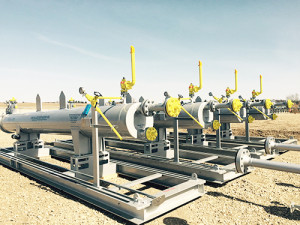 Steelhead installs its patented Desander upstream from customers’ surface equipment to remove sand and other particulates such as asphalts and free precipitates, from natural gas and liquid streams. Steelhead’s Desander works by changing the flow parameters, reducing the flow velocities to the point where the sand drops out while gas and fluids are carried through. This process involves no bags, filters, screens and virtually no pressure drop.
Steelhead installs its patented Desander upstream from customers’ surface equipment to remove sand and other particulates such as asphalts and free precipitates, from natural gas and liquid streams. Steelhead’s Desander works by changing the flow parameters, reducing the flow velocities to the point where the sand drops out while gas and fluids are carried through. This process involves no bags, filters, screens and virtually no pressure drop.
Steelhead Desanders function effectively over a broad range of flowrates. Sized to work with high initial rates, they are also able to handle the higher gas phase velocities that develop as production continues and flow pressures drop. This mechanism allows the same equipment to remain in service despite changing conditions. For wells with continuing sand production, the Steelhead Desander will protect your surface equipment throughout.
The Technology
- Removes sand using a patented process application of basic physics and fluid dynamics principals
- Allows produced fluids and gas to pass through the desander resulting in virtually all solid particles collecting on the bottom of the desander
- Web based sand monitoring system – Sand Sentry – allows real-time sand monitoring to determine the frequency of servicing as determined from observed conditions
- Simple safe operating and servicing procedures
- Ultra-sonic thickness (UTS) testing verifies that the desanders are not eroded
| Problem | Impact | Solution |
| Wells producing sand, | Loss of containment
Pipework erosion Plugged separators Plugged pipelines |
Desanders safely capture 99% of sand |
| Wells producing clays | Pumping issues
Plugged separators Plugged pipelines |
Desanders safely capture 99% of sand |
| Wells producing solids | Pumping issues
Plugged separators Plugged pipelines |
Desanders safely capture 99% of sand |
| Loss containment due to sand erosion | Regulatory compliance breach, risk to personnel, environment and plant | Desanders safely capture and monitor 99% of solids production, thus eliminating the risk of loss of containment. |
